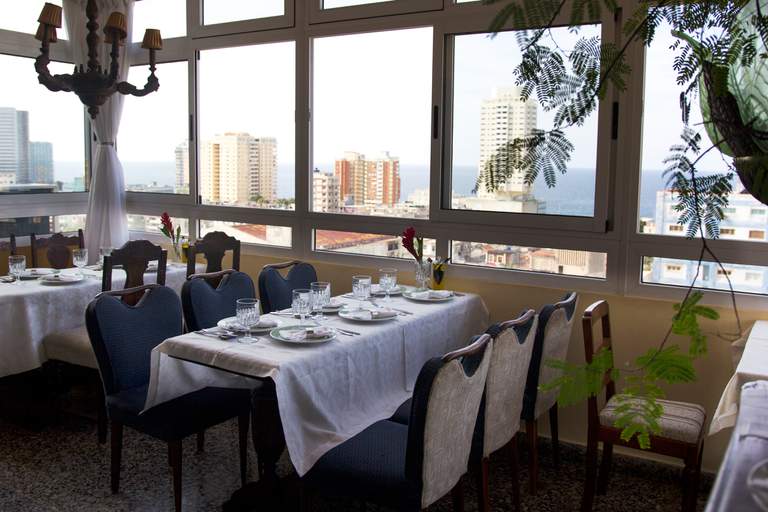
Jonathan Reyes Gil and Raudel Carrazana are the owner and chef of Porto Habana, a popular privately owned restaurant in Havana. They are among a growing number of Cubans opening their own businesses. Photo by Brian Canelles.
Private Restaurants Key to Cuba’s Changing Economy
Renowned restauranteur Jonathan Reyes Gil said that opening night at his now hugely popular restaurant, Porto Habana, was “terrifying.”
He had never worked in a restaurant before. Neither had anyone on his staff. Their tables filled up immediately.
“There were people standing all over, and we had only a few tables,” he said. “I was scared. I was nervous, but very happy, too.”
Gil is one of a growing number of small business owners in Cuba charting new territory in the Communist country that, for decades, allowed few official exceptions to state-run enterprises. He’s had to learn the ropes with no blueprint, few mentors, and limited resources.
Gil left Cuba in 2001 and moved to Europe. In 2011, he was visiting his ailing mother when Raúl Castro announced a series of reforms. Through gradually increasing opportunities for private entrepreneurs, he would decentralize a small number of state sectors and, eventually, reduce the number of Cubans on the government payroll.
Gil decided right then and there that he would move back to Cuba and open a restaurant. His mother’s Havana apartment, he said, was the perfect location, with a stunning view of the city, the Malecón, and the sea.
“This is a special place,” he says. “I knew that if I could get clients to come up here, I could do it.”
Source: Engage Cuba Coalition
The changes that began in 2011 are transforming the Cuban economy. The number of private business licenses issued by the Cuban government has grown more than four-fold. Today, the private sector employs an estimated one-third of Cuba’s residents, many of them in the tourism industry.
There are still several restrictions placed on the businesses — both legal and circumstantial. For example, paladares, or privately-owned restaurants, can’t have more than 50 seats. And their owners are subject to the same rations and scarcity as everyone else in Cuba.
Gil doesn’t own a car, and often he and his employees will spend hours riding around town in taxis to procure enough food or beverages to open their doors.
He travels back to Portugal as often as he can to obtain spices and asks people visiting him to bring such things as vanilla and nutmeg, which he says are impossible to find in Cuba.
He also had to leave to get the training he felt he needed to make his enterprise successful. In 2013, he took an accelerated, eight-month course in restaurant management and tourism in Porto, Portugal. His then-boyfriend and chef, Raudel Carrazana, joined him and studied Portugese cooking.
Their hard work has paid off. Today, dinner at Porto Habana is a sought-after reservation for celebrities visiting Havana. Gil says recent guests have included shoe designer Christian Louboutin and actor Ian McKellen.
Over time, he has earned enough money to invest in more furniture and décor and create a tranquil, seaside oasis.



Photos by Brian Canelles.
Gil says he works long days, and that life is still more difficult than it was in Portugal, where he worked as a model — but he wouldn’t change a thing.
Many of his foreign customers come to his restaurant and tell him that they find Cuban food boring or lackluster, but not at Porto Habana.
“I love this work more than anything,” he says. “I am so proud that they can come here and have good Cuban food, and be taken care of, and enjoy this view of the city.”


